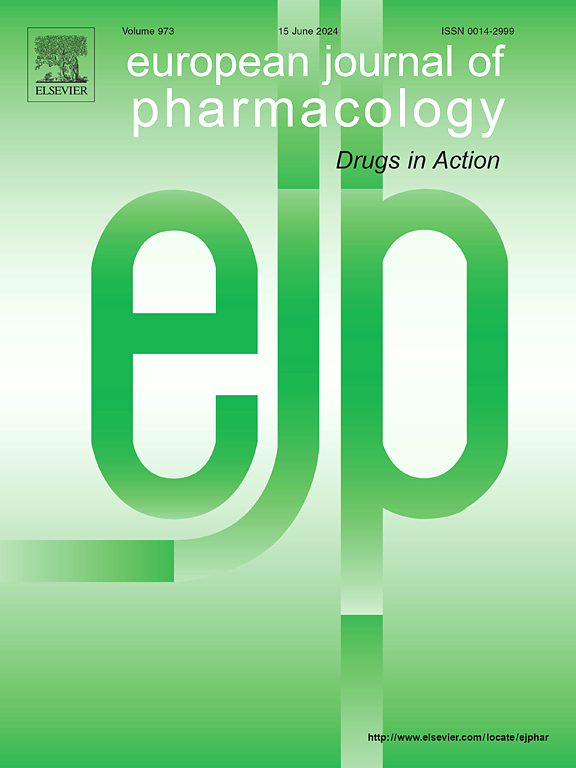牛磺酸通过抑制fpr2调控的巨噬细胞M1极化改善肝纤维化
IF 4.2
3区 医学
Q1 PHARMACOLOGY & PHARMACY
引用次数: 0
摘要
肝纤维化是一种可逆的病理生理状况,其特征是细胞外基质过度沉积,如果不及时治疗,可发展为肝硬化和肝功能衰竭。牛磺酸是一种含硫氨基酸,可以保护肝脏免受损害。然而,牛磺酸对肝纤维化的影响尚未完全阐明。在这项研究中,我们使用氨基酸代谢组学、基因表达微分析和单细胞RNA测序(scRNA-seq)来研究牛磺酸、甲酰基肽受体2 (Fpr2)和促炎巨噬细胞在人肝纤维化切片和两种不同的小鼠肝纤维化模型中的作用。还使用牛磺酸转运体SLC6A6野生型和敲除的窝友模型和关键元件抑制剂。我们发现牛磺酸水平在人和小鼠的纤维化切片中显著降低,外源性牛磺酸补充通过SLC6A6减轻了纤维化。此外,基因表达芯片分析和scRNA-seq分析表明,外源性牛磺酸主要通过调节fpr2相关的巨噬细胞状态来减轻肝纤维化。wrw4介导的Fpr2抑制可改善M1巨噬细胞极化,减轻肝纤维化。此外,外源性牛磺酸通过抑制NF-κBp65磷酸化抑制fpr2调节的巨噬细胞M1极化和相关促炎细胞因子的产生;此外,SLC6A6缺乏或用NF-κB抑制剂BAY治疗肝纤维化小鼠模型会削弱牛磺酸的这种保护作用。因此,牛磺酸通过抑制Fpr2/NF-κ bp65调控的巨噬细胞M1极化,对肝纤维化具有保护作用,突出了其潜在的治疗剂。本文章由计算机程序翻译,如有差异,请以英文原文为准。
Taurine ameliorates liver fibrosis by repressing Fpr2-regulated macrophage M1 polarization
Liver fibrosis is a reversible pathophysiological condition characterized by excessive extracellular matrix deposition that can progress to cirrhosis and liver failure if left untreated. Taurine, a sulfur-containing amino acid, protects the liver from damage. However, the effects of taurine on liver fibrogenesis have not been completely elucidated. In this study, we used amino acid metabolomics, gene expression microanalysis, and single-cell RNA sequencing (scRNA-seq) to investigate the roles of taurine, formyl peptide receptor 2 (Fpr2), and proinflammatory macrophages in liver fibrosis in human fibrotic sections and two distinct mouse models of liver fibrosis. Taurine transporter SLC6A6 wild-type and knockout littermate models and critical element inhibitors were also used. We found that taurine levels were significantly reduced in both human and murine fibrotic sections and that exogenous taurine supplementation alleviated fibrosis via SLC6A6. Furthermore, gene expression microarray analysis and scRNA-seq analyses demonstrated that exogenous taurine mitigated liver fibrosis, mainly by regulating Fpr2-related macrophage status. WRW4-mediated inhibition of Fpr2 ameliorated M1 macrophage polarization and alleviated liver fibrosis. Additionally, exogenous taurine suppressed Fpr2-modulated macrophage M1 polarization and the production of associated proinflammatory cytokines by repressing NF-κBp65 phosphorylation; moreover, SLC6A6 deficiency or treatment of liver fibrosis mouse models with an NF-κB inhibitor, BAY, impaired this protective effect of taurine. Therefore, taurine exerts a protective effect against liver fibrosis by repressing Fpr2/NF-κBp65-regulated macrophage M1 polarization, highlighting its potential therapeutic agent.
求助全文
通过发布文献求助,成功后即可免费获取论文全文。
去求助
来源期刊
CiteScore
9.00
自引率
0.00%
发文量
572
审稿时长
34 days
期刊介绍:
The European Journal of Pharmacology publishes research papers covering all aspects of experimental pharmacology with focus on the mechanism of action of structurally identified compounds affecting biological systems.
The scope includes:
Behavioural pharmacology
Neuropharmacology and analgesia
Cardiovascular pharmacology
Pulmonary, gastrointestinal and urogenital pharmacology
Endocrine pharmacology
Immunopharmacology and inflammation
Molecular and cellular pharmacology
Regenerative pharmacology
Biologicals and biotherapeutics
Translational pharmacology
Nutriceutical pharmacology.

 求助内容:
求助内容: 应助结果提醒方式:
应助结果提醒方式:


